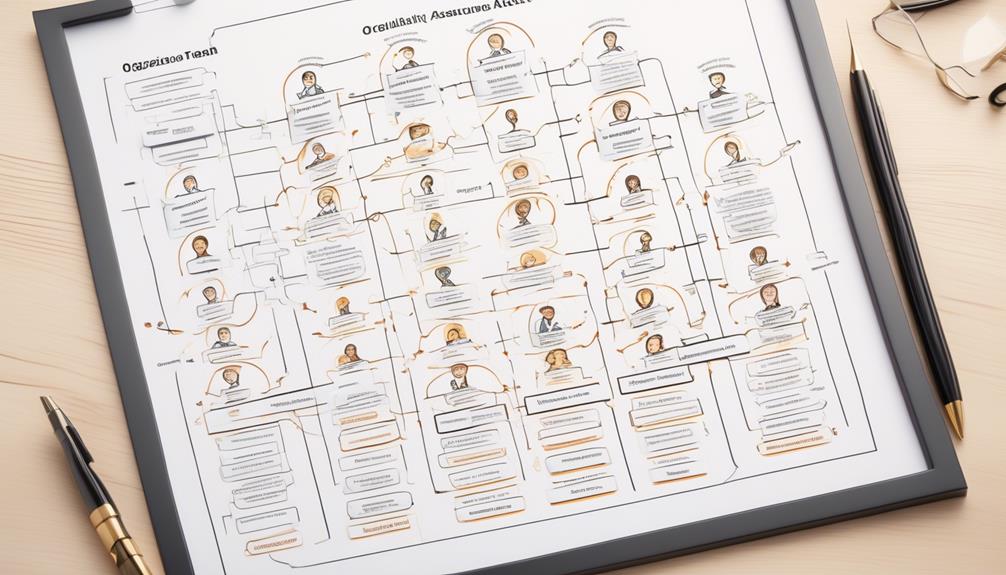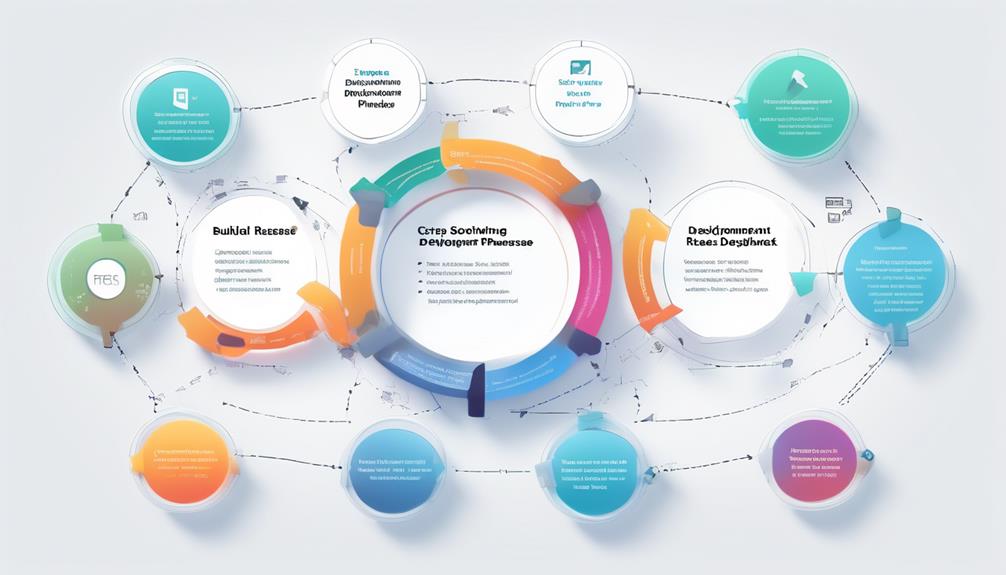Fundamentals of SQA
How Do You Structure a Quality Assurance Team?
Structuring a quality assurance team is crucial for a successful project. Learn how to build and organize a highly effective QA team for optimal results and performance.

We have all been part of “quality assurance” teams where it seems like chaos is taking over instead of actual assurance. But don’t worry, because there is a method to the madness. Building a quality assurance team is like creating a piece of art, combining technical skill, process improvement, and effective team collaboration.
Whether you're a seasoned QA manager or just dipping your toes into the world of software testing, understanding the key elements of building a strong QA team is crucial for ensuring the success of your projects.
So, how exactly do you go about structuring a quality assurance team that delivers efficiency and accuracy? Let's explore the essential components that make up a high-performing QA team.
Key Takeaways
- Defining clear roles and responsibilities within the QA team is crucial for effective coordination and task allocation.
- Establishing communication channels and protocols, utilizing collaboration tools, and encouraging open feedback can foster a culture of open communication and transparency within the QA team.
- Implementing best practices such as consistent documentation, automated testing, and continuous integration can optimize the efficiency and effectiveness of the QA team's processes.
- Regularly assessing and optimizing the team structure, roles, processes, and providing training and mentorship initiatives are essential for enhancing the skills and capabilities of team members and adapting to changing project requirements.
Defining QA Team Roles
Defining QA team roles involves carefully delineating the responsibilities and competencies of each member to ensure a well-organized and efficient testing process.
The QA Manager/Test Manager plays a crucial role in leading and managing the entire team, setting the test strategy, assigning tasks, and auditing the QA process.
Working closely with the QA Manager, the QA Team Lead/Test Lead supervises and coordinates team activities, maintaining the test plan and documentation.
The QA Architect/Test Architect is responsible for preparing the test infrastructure, optimizing the testing process, and aligning requirements with resources and competencies.
Within the team, the Manual QA Engineer/Tester conducts manual tests, analyzes requirements, develops test cases, reports bugs, and verifies software consistency.
On the other hand, the Test Automation Engineer/Automation QA Engineer is tasked with performing automated tests, building frameworks, writing and maintaining test scripts, and continuously improving the automation framework.
Defining these roles is essential for effective project management and development. Each member plays a specific and integral part in ensuring the quality and reliability of the software test process within the organization.
Establishing Communication Channels

Establishing efficient communication channels is crucial for ensuring that the carefully outlined QA team roles are effectively coordinated and the testing process runs smoothly. To achieve this, it's essential to clearly define communication channels and protocols within the QA team. This ensures that information flows efficiently and effectively.
Regular team meetings and status updates play a vital role in facilitating open communication and transparency among team members. Additionally, the use of collaboration tools and platforms such as Slack, Microsoft Teams, or Jira can streamline communication and document sharing within the team.
Furthermore, establishing a clear escalation process for raising concerns or issues is paramount. This ensures that all team members are aware of the appropriate channels for addressing problems. Encouraging feedback and suggestions from all team members also fosters a culture of open communication and continuous improvement within the QA team.
Implementing Best Practices
To ensure the successful implementation of best practices within the quality assurance team structure, we meticulously analyze industry standards and adapt our processes accordingly, aiming for optimal efficiency and quality. As the QA Manager, it is imperative to lead the team in integrating best practices that align with the specific needs of our software development project. By embracing best practices, we can enhance the overall effectiveness of our testing processes and cultivate a culture of continuous improvement within the team.
| Best Practice | Purpose | Implementation Strategy |
|---|---|---|
| Consistent Documentation | Ensure traceability and knowledge transfer | Employ standardized templates and version control systems for all documentation. |
| Automated Testing | Improve efficiency and accuracy | Invest in robust automation tools and establish clear guidelines for automated test development. |
| Continuous Integration | Facilitate early bug detection and seamless integration | Implement continuous integration tools and establish a regular integration schedule. |
Optimizing Existing QA Team

After integrating best practices aligned with our project's needs, our next focus is optimizing the existing QA team structure to enhance efficiency and accountability. To achieve this, we're assessing the current team structure and roles, aiming to identify areas for improvement and optimization.
Clear delineation of roles and responsibilities for each team member is crucial to ensure an efficient division of work and enhance individual accountability. Additionally, we're evaluating the existing processes and workflows to identify any bottlenecks and areas for improvement.
By implementing training programs and mentorship initiatives, we aim to enhance the skills and capabilities of the QA team members, thus contributing to the overall quality of our outputs. We recognize the importance of regularly reviewing and adjusting the team structure and processes to adapt to changing project requirements and industry best practices.
Our goal is to create a dynamic and efficient QA team structure that aligns with our quality assurance objectives and fosters continuous improvement.
Key Elements of Team Structure
We meticulously define the key elements of our QA team structure to ensure clarity, accountability, and optimal efficiency in our testing processes. Our QA team is composed of essential roles, each with specific responsibilities crucial to the quality assurance of software.
The QA Manager/Test Manager leads and manages the entire team, sets test strategy, assigns tasks, and audits the QA process. Working closely with the manager, the QA Team Lead/Test Lead supervises and coordinates team activities, ensuring that the test plan and documentation are maintained.
The QA Architect/Test Architect prepares the test infrastructure, optimizes the testing process, and aligns requirements with resources and competencies. Manual QA Engineers/Testers conduct manual tests, analyze requirements, develop test cases, report bugs, and verify software consistency.
On the other hand, Test Automation Engineers/Automation QA Engineers are responsible for performing automated tests, building frameworks, writing and maintaining test scripts, and improving the automation framework.
Each role is meticulously structured to contribute to the overall efficiency and effectiveness of the QA team, building a quality assurance process that ensures the delivery of high-quality software.
QA Manager Responsibilities

As QA Managers, our role encompasses team leadership, process improvement, and resource management.
We're responsible for setting the direction and tone for the QA team, ensuring that processes are efficient and effective, and making sure that the team has the resources and support needed to succeed.
Our attention to detail, methodical approach, and analytical mindset are crucial in fulfilling these responsibilities.
Team Leadership
The QA Manager takes charge of leading and managing the team, setting the test strategy, assigning tasks, and auditing the QA process.
As team leads, we guide the team by creating and maintaining a collaborative and supportive environment. Our responsibilities include empowering team members to excel in their roles, fostering open communication, and providing mentorship to encourage professional growth.
By setting clear expectations and promoting a culture of continuous improvement, we ensure that the team operates cohesively and efficiently. Our commitment to effective team leadership involves aligning individual strengths with project requirements, promoting accountability, and fostering a strong sense of camaraderie.
Through our leadership, we drive the team towards achieving excellence in quality assurance processes and outcomes.
Process Improvement
In the pursuit of process improvement within the realm of quality assurance management, the focus is placed on refining and enhancing the efficiency and effectiveness of testing procedures and protocols. This necessitates a comprehensive understanding of the software development life cycle to identify areas for enhancement.
As a quality assurance team, we strive to develop and maintain standards that promote effective quality assurance. Our approach involves a methodical analysis of current processes to identify bottlenecks and inefficiencies, followed by the implementation of targeted improvements.
It's imperative to foster a culture of continuous improvement within the team, encouraging proactive contributions to streamline processes. By prioritizing process improvement, we ensure that our quality assurance team operates at the highest level of efficiency and delivers exceptional results.
Resource Management
Streamlining testing processes to ensure efficiency and effectiveness is an essential aspect of quality assurance management, and the QA manager plays a pivotal role in resource allocation and team development.
When managing resources, it's crucial to consider the emotional and professional needs of our team members. For them to excel, we must provide opportunities for growth and mentorship, fostering a sense of fulfillment and purpose.
Additionally, understanding the challenges and pressures that QA engineers work under is vital for creating a supportive environment. Moreover, by aligning their efforts with the overall quality assurance process, we can optimize their contributions to the team.
Ultimately, the QA manager's key roles in resource management include nurturing a great QA team, implementing a cohesive testing strategy, and ensuring that team members are equipped with the necessary resources to succeed.
QA Team Lead Duties

As QA Team Leads, our responsibilities encompass a range of leadership duties and performance evaluations.
We're tasked with overseeing the team's activities, ensuring adherence to quality standards, and mentoring team members for continuous improvement.
Our role also involves collaborating closely with the QA Manager to align test strategies and optimize resource utilization.
Leadership Responsibilities
Assuring quality and maintaining standards is a critical aspect of the leadership responsibilities for QA team leads.
As QA team leads, we play a pivotal role in shaping the product and process quality. Our leadership responsibilities include:
- Establishing clear standards and procedures to ensure the delivery of high-quality products.
- Training and mentoring team members to uphold these standards, fostering a culture of excellence within our teams.
- Auditing processes rigorously to identify areas of improvement and ensure the highest levels of software quality assurance.
Team Performance Evaluation
In our role as QA team leads, ensuring quality and maintaining standards naturally extends to the critical task of evaluating team performance.
We establish clear job descriptions, roles, and responsibilities for QA analysts and testers to ensure efficient division of work.
Developing and implementing a team performance evaluation system for software QA allows us to track and assess individual and team progress against quality standards.
Conducting regular performance reviews and providing constructive feedback supports continuous improvement and professional development.
Collaborating with team members to set meaningful performance goals and objectives aligned with the overall QA strategy ensures a focused approach.
Encouraging open communication and transparency fosters a positive and supportive team culture, promoting collaboration and accountability.
This methodical and analytical approach to team performance evaluation is essential in upholding quality standards within QA teams.
QA Architect Role

The QA Architect role encompasses designing and implementing test infrastructure, optimizing testing processes, and aligning requirements with resources and competencies. As a QA architect, we play a crucial role in the software development process, ensuring that the quality assurance (QA) testing is robust and aligned with the organization's objectives.
Here are key aspects of the QA Architect role:
- Collaborating with cross-functional teams to align testing strategies with business and technical objectives, ensuring that QA efforts are in sync with the overall organizational goals.
- Driving the adoption of best practices, tools, and technologies to enhance overall testing efficiency and effectiveness, staying abreast of the latest advancements in the field.
- Providing technical leadership, mentorship, and guidance to QA team members, fostering a culture of innovation and continuous improvement, empowering the team to deliver exceptional QA outcomes.
The QA Architect role requires a deep understanding of QA testing, and it's essential for ensuring the seamless integration of testing processes within the software development lifecycle. As a QA architect, we're dedicated to creating a testing architecture that isn't only scalable and sustainable but also aligns with the ever-evolving needs of the organization.
Manual QA Engineer Tasks

Manual QA engineers ensure comprehensive test coverage by analyzing requirements and developing test cases for manual testing. They work closely with the development and product teams to understand the requirements and design an effective test strategy. By utilizing their analytical skills, manual QA engineers identify various scenarios and edge cases to ensure thorough test coverage.
They meticulously document the test plans, ensuring that all requirements are addressed and potential risks are mitigated through systematic testing. Throughout the manual testing phase, they conduct rigorous tests to uncover software defects, meticulously report bugs, and verify the consistency and functionality of the software.
Their attention to detail and methodical approach in writing test cases and executing manual testing procedures are essential in delivering high-quality, reliable software products.
Test Automation Engineer Responsibilities

Working with the meticulous attention to detail and methodical approach characteristic of our manual QA engineers, test automation engineers are tasked with building and maintaining automated test scripts to support software testing efforts.
In this role, we focus on the following responsibilities:
- Identifying areas for test automation and implementing appropriate automation tools and frameworks, thereby increasing the efficiency and reliability of the testing process.
- Collaborating with cross-functional teams to understand testing requirements and ensure effective test coverage, fostering a comprehensive approach to automated testing.
- Executing and monitoring automated test suites to validate software functionality and identify defects, contributing to the overall quality of the software product.
QA Analyst Responsibilities

As QA analysts, our responsibilities encompass the entire testing process, from developing and executing detailed test plans to creating and executing test cases and scenarios.
We meticulously identify and document any bugs, glitches, or errors and ensure their resolution by logging and tracking them.
Additionally, collaboration with team members is crucial to guarantee that the software meets client expectations and quality standards.
Testing Process Overview
The responsibilities of QA analysts in the testing process overview encompass:
- Analyzing requirements
- Developing test cases
- Executing tests
- Reporting bugs
- Verifying software consistency
This ensures a meticulous and methodical approach to maintaining quality standards in software development.
In this phase, Test Management plays a critical role in:
- Coordinating and prioritizing testing activities
- Ensuring comprehensive test coverage
- Tracking defects effectively
It also involves the seamless integration of:
- Manual testing conducted by QA engineers
- Automated testing performed by automation QA engineers
This leverages the strengths of both approaches.
Additionally, QA managers must oversee:
- The validation of quality criteria
- Maintenance of test documentation
- Effective collaboration with other team members
These elements collectively ensure a robust and systematic approach to software testing, vital for delivering high-quality products.
Bug Tracking System
In maintaining meticulous attention to detail and ensuring software consistency, the bug tracking system forms a crucial aspect of QA analysts' responsibilities, encompassing the monitoring and tracking of reported bugs throughout their lifecycle.
QA analysts collaborate with test managers, developers, and stakeholders to prioritize and assign bugs, ensuring efficient resolution and product quality.
They verify bug fixes to prevent the introduction of new defects and generate bug reports to provide insights into software quality.
Additionally, they contribute to the continuous improvement of the bug tracking system by providing feedback and suggesting enhancements based on user experience.
This systematic approach to bug tracking, using testing tools and project documentation, allows the quality assurance team to maintain a high standard of product quality and facilitate efficient bug resolution.
Quality Assurance Plan Development

With the goal of ensuring consistent quality and adherence to standards, we'll develop a comprehensive quality assurance plan to guide our initiatives. In order to achieve this, we'll carefully consider the following key aspects in the development of our quality assurance plan:
- Thorough Scope Identification: We'll work closely with the project manager to clearly define the scope of the project, ensuring that all aspects are considered and incorporated into the quality assurance plan.
- Selection of Testing Methods: Our team will utilize advanced software to identify and implement the most effective testing methods for our specific project, ensuring comprehensive coverage and accuracy in our quality assurance processes.
- Process Refinement and Optimization: Continuous improvement is at the core of our quality assurance plan development. We'll focus on refining and optimizing the (QA) process to ensure that our team is consistently delivering high-quality results.
Recruiting QA Professionals

As we consider the process of recruiting QA professionals, it's essential to thoroughly outline the job requirements to pinpoint the necessary technical skills and experience needed for the role.
A meticulous interview process is crucial to assess candidates' capabilities and ensure their alignment with the quality assurance team's objectives.
Job Requirements
Seeking professionals with a strong understanding of the software development lifecycle, testing methodologies, and quality assurance processes, as well as proficiency in using testing tools and technologies such as Selenium, Appium, and QA Touch.
When considering job requirements for quality assurance engineers, it's crucial to emphasize the need for individuals who possess a meticulous approach to creating and executing test plans, test cases, and automated testing scripts.
Additionally, the ability to thoroughly analyze and report software defects, and ensure software consistency across diverse environments, is paramount.
Furthermore, effective communication and collaboration skills are essential for seamless integration within cross-functional teams and interactions with stakeholders.
These requirements are vital for building a cohesive and effective quality assurance team that can uphold the highest standards in software testing and reliability.
Interview Process
During the interview process for recruiting QA professionals, our focus remains on identifying individuals who exhibit a meticulous approach to test planning, execution, and defect analysis, as well as effective communication and collaboration skills essential for seamless integration within cross-functional teams and interactions with stakeholders.
| Skills | Experience in Software | Test Team Collaboration | Communication | Product Owner Interaction |
|---|---|---|---|---|
| Meticulous testing | Extensive | Ability to work | Clear and concise | Understanding of |
| planning | experience | collaboratively in | communication | product requirements |
| in software testing | a test team environment | skills | and stakeholder needs |
This table represents the key skills and experiences we look for during the interview process when building a quality assurance team from scratch. Candidates should possess a blend of technical expertise and interpersonal skills to ensure the success of the team.
Quality Assurance Training Programs

Quality Assurance Training Programs impart essential skills and knowledge in software testing, quality control, and assurance methodologies. When considering the importance of these programs, there's a range of emotions that can arise:
- Enthusiasm: It's exciting to gain expertise in manual and automated testing, test management, and various types of testing to ensure product quality.
- Confidence: These programs instill confidence by focusing on tools, techniques, and best practices for effective quality assurance.
- Motivation: Understanding the impact of quality assurance on product success motivates the entire QA team to work diligently in the process of developing and implementing quality assurance strategies.
Quality Assurance Training Programs are essential for equipping individuals with the ability to build and manage a successful quality assurance team. The training also covers the significance of quality assurance in software development, impacting the team's ability to work effectively, especially in Agile teams. Participants also gain insight into the importance of performance testing and its role in ensuring overall quality assurance (QA).
Individual Task Assignments

Having gained expertise in quality assurance through training programs, we now turn our focus to clearly defining individual task assignments for our team members based on their expertise and skills. Assigning individual tasks within the quality assurance team is a critical aspect of ensuring efficient and effective testing processes. Each team member will be assigned tasks such as functional testing, manual tests, usability testing, and security testing based on their specific strengths and competencies. By aligning the individual's skills with the assigned tasks, we can optimize the overall performance of the team and ensure that each aspect of the quality assurance process is meticulously executed.
In defining these task assignments, we prioritize transparent communication to ensure that each team member fully understands their responsibilities and the associated deadlines. We also consider workload distribution to prevent overburdening any particular team member and to maintain a balanced allocation of tasks. Regular monitoring and support mechanisms will be put in place to track each team member's progress, provide necessary assistance, and ensure that individual tasks are completed in a timely and proficient manner. This approach will enable us to streamline our quality assurance processes and drive the team towards achieving mastery in their respective areas of expertise.
Frequently Asked Questions
How Should QA Team Be Structured?
We structure a QA team by carefully considering the skills and roles needed for comprehensive testing.
Each member, from the QA Manager to the Manual QA Engineer and Test Automation Engineer, plays a crucial part in ensuring software quality.
Balancing leadership, coordination, infrastructure, manual testing, and automation expertise is essential for a well-structured team.
This approach enhances efficiency, accuracy, and adaptability, ultimately leading to robust quality assurance processes.
How Do I Set up a Quality Assurance Team?
When setting up a quality assurance team, we focus on aligning our structure with the organization's goals and values. This ensures that the team's efforts contribute to the overall mission and vision.
We establish clear roles and responsibilities, fostering a collaborative environment where each member's strengths are leveraged.
How Do You Build a Successful QA Team?
To build a successful QA team, we focus on the following:
- Defining clear roles
- Understanding production and test environments
- Utilizing machine learning
- Emphasizing effective test management
- Considering factors such as recruiting, training, and developing a quality assurance plan
By doing so, we ensure a well-structured team that's capable of delivering high-quality software products.
This approach allows us to build a team that excels in efficiency, accuracy, and effective test coverage.
What Is the Quality Assurance Structure?
In a quality assurance structure, the roles and responsibilities are divided as follows:
- QA manager: The QA manager leads the team and sets the overall quality assurance strategy. They are responsible for overseeing the entire QA process and ensuring that it aligns with the organization's goals and objectives.
- QA team lead: The QA team lead coordinates the activities of the quality assurance team. They work closely with the QA manager to ensure that tasks are assigned, deadlines are met, and resources are allocated effectively.
- QA architect: The QA architect is responsible for preparing the necessary infrastructure for quality assurance activities. This includes setting up testing environments, configuring test tools, and ensuring that the necessary hardware and software resources are available.
- Manual QA engineer: The manual QA engineer is responsible for conducting tests manually. They follow test cases and scripts to identify defects and ensure that the software meets the required quality standards. They are also involved in test planning, test execution, and defect reporting.
- Test automation engineer: The test automation engineer is responsible for developing and maintaining automated test scripts. They use specialized tools to automate repetitive and time-consuming test cases, allowing for faster and more efficient testing. They also collaborate with the manual QA engineer to identify areas where automation can be applied.
Working together, these roles collaborate closely to ensure software consistency and maintain high-quality standards. Their structured approach to quality assurance is crucial for identifying and addressing any issues or defects before the software is released.
Conclusion
So, in conclusion, structuring a quality assurance team is a piece of cake! Just define roles, establish communication, implement best practices, optimize the team, develop a QA plan, recruit professionals, and provide training.
Easy peasy, right? With attention to detail and a methodical approach, you'll have a top-notch QA team in no time.
Happy structuring!
Randy serves as our Software Quality Assurance Expert, bringing to the table a rich tapestry of industry experiences gathered over 15 years with various renowned tech companies. His deep understanding of the intricate aspects and the evolving challenges in SQA is unparalleled. At EarnQA, Randy’s contributions extend well beyond developing courses; he is a mentor to students and a leader of webinars, sharing valuable insights and hands-on experiences that greatly enhance our educational programs.
Fundamentals of SQA
Navigating Software Quality Assurance Job Locations
Looking for jobs in software quality assurance? Explore various industries such as technology, healthcare, finance, and more to find opportunities in software quality assurance.

As we explore the world of software quality assurance, it appears that we have come to a pivotal point, surrounded by various paths that lead to different career opportunities.
The demand for professionals in this field has been steadily growing, and the avenues for SQA jobs are as diverse as the industries that rely on robust software.
Curious to know where these opportunities lie and how to embark on a fulfilling career in software quality assurance?
Stick with us as we unravel the thriving locations for SQA jobs, highlight the in-demand job titles, and offer strategies for landing coveted roles in this dynamic field.
Key Takeaways
- Insurance companies like COUNTRY Financial and Honeywell, finance companies like AmeriFlex, aerospace giants like Boeing, and technology solution providers like Origami Risk LLC offer job opportunities in Software Quality Assurance.
- Thriving locations for SQA jobs include Bloomington, IL, Alpharetta, GA, and Madison, AL.
- SQA professionals can transition into roles in product management, DevOps, and quality engineering.
- In-demand SQA job titles include Software Development Engineer in Test (SDET), Sr Software Quality Specialist, Software Quality Assurance Analyst, Software Technical Analyst, and Quality Assurance Engineer.
SQA Job Opportunities by Industry
In our exploration of SQA job opportunities by industry, we find that various sectors offer a diverse range of positions for professionals in the field.
Insurance companies such as COUNTRY Financial and Honeywell are seeking skilled individuals for roles like Software Quality Assurance Analyst and Quality Assurance Engineer.
Finance companies like AmeriFlex are hiring for Quality Assurance Analyst jobs.
Aerospace giants like Boeing are offering positions for Quality Assurance Analysts, Engineers, and Software Development Engineers in Test (SDET).
Technology solution providers like Origami Risk LLC are seeking Sr. Software Quality Specialists and Quality Assurance Engineers.
These positions require proficiency in Agile methodologies, Python, database operations, GitLab pipelines, life insurance processes, performance testing, and cloud-based SaaS solutions.
The sheer breadth of opportunities across these industries reflects the growing demand for QA professionals and the diverse career paths available, including transitions to product management, DevOps, customer experience leadership, and enterprise architecture.
Thriving Locations for SQA Jobs

Thriving in various locations such as Bloomington, IL, Alpharetta, GA, and Madison, AL, SQA jobs offer diverse opportunities with remote work options and hybrid schedules, reflecting the adaptable nature of the field.
These locations are home to companies such as COUNTRY Financial, Honeywell, Boeing, and Origami Risk LLC, which actively seek SQA professionals. These positions often focus on insurance processes and Agile methodologies.
With over 15,000 SQA job opportunities in the United States, there’s a robust demand for SQA professionals across different job titles and companies.
Additionally, SQA professionals can leverage their organizational ability and critical thinking skills to transition into roles in product management, DevOps, and quality engineering.
Continuous learning is crucial for SQA professionals to stay updated with industry trends, performance engineering techniques, and software test automation tools.
This adaptability and the diverse opportunities available in these locations make them thriving hubs for SQA jobs.
Career Paths for SQA Professionals
Exploring various career paths for Software Quality Assurance (SQA) professionals involves considering the diverse opportunities available in the field and the potential for leveraging skills in areas such as product management, DevOps, and quality engineering. As SQA professionals, we can advance our careers by transitioning into roles such as Quality Assurance Analyst, Software QA, or Quality Assurance Manager. The table below outlines the key responsibilities and skills required for each of these career paths:
Career Path Responsibilities Required Skills Quality Assurance Analyst Develop and execute software test plans, identify defects, and ensure compliance with quality standards. Strong analytical skills, attention to detail, knowledge of testing methodologies and tools. Software QA Oversee the entire software development process to ensure product quality, identify areas for improvement, and implement best practices. In-depth understanding of software development lifecycle, coding skills, communication abilities. Quality Assurance Manager Lead a team of QA professionals, establish quality standards, and collaborate with cross-functional teams to enhance overall product quality. Project management, leadership, strategic planning, and decision-making skills.
These career paths offer SQA professionals the opportunity to progress into more challenging and rewarding roles, leveraging their expertise to drive quality and innovation within the software development lifecycle.
In-Demand SQA Job Titles

With a growing demand for skilled professionals in the field of Software Quality Assurance (SQA), numerous job titles have emerged to cater to the diverse needs of the industry. These titles include Software Development Engineer in Test (SDET), Sr Software Quality Specialist, Software Quality Assurance Analyst, Software Technical Analyst, and Quality Assurance Engineer.
Each of these positions plays a critical role in ensuring the quality and reliability of software products. The Software Development Engineer in Test (SDET) is responsible for developing and implementing testing processes within the software development lifecycle, while the Sr Software Quality Specialist oversees and manages the quality assurance processes within a company.
The Software Quality Assurance Analyst focuses on identifying and resolving software defects, ensuring that the final product meets quality standards. Similarly, the Software Technical Analyst and the Quality Assurance Engineer roles involve analyzing, testing, and evaluating software systems to ensure they meet specified requirements and standards.
These in-demand SQA job titles reflect the varied responsibilities and specializations within the software quality assurance field, offering opportunities for professionals with diverse skill sets and expertise.
Strategies for Landing SQA Jobs
As professionals seeking to secure positions in Software Quality Assurance (SQA), we can capitalize on our expertise in Agile methodologies and proficiency in Python, along with a deep understanding of data structures, to qualify for SQA roles at esteemed companies like COUNTRY Financial and Honeywell. To enhance our chances of landing SQA jobs, we should also consider gaining experience in developing GitLab pipelines and acquiring knowledge of life insurance processes, which are sought after by companies like AmeriFlex, Boeing, and Origami Risk LLC. Additionally, developing software solutions, supporting testing and problem-solving, and executing quality assurance testing will prepare us for SQA roles at various companies, including positions like Software Quality Analyst – Manual Tester at Cantaloupe Inc, Optomi, Vaporstream, Inc., and IDR, Inc.
Strategies for Landing SQA Jobs Gain expertise in Agile methodologies Proficiency in Python Deep understanding of data structures Develop GitLab pipeline experience Acquire knowledge of life insurance processes Explore software testing and problem-solving Transition to different roles using transferable skills Explore app development for expanded career opportunities Pursue positions at actively hiring companies
Frequently Asked Questions
What Is the Job of a Software Quality Assurance?
As software quality assurance analysts, we develop and execute test plans and cases to ensure software quality. We collaborate with cross-functional teams to identify and report defects, conducting thorough regression testing.
Strong knowledge of testing methodologies, test case design, and test automation tools is essential. This role offers an average salary of $78,000 per year, with opportunities for career growth and specialization.
Continuous learning is crucial to stay updated and access career advancement opportunities.
Is Software Quality Assurance in Demand?
We find that software quality assurance is indeed in high demand, with over 15,000 available jobs in the United States.
Skills in Agile methodologies, Python, database operations, and GitLab pipelines are sought after.
The average salary for QA analysts is $78,000 per year, with potential to earn up to $110,000.
Continuous learning is essential, focusing on performance engineering, software test automation tools, and reducing software defects.
How Hard Is It to Get a Job as a Qa?
Getting a job as a QA can be challenging, but our dedication and expertise make it achievable. We prioritize continuous learning, communication, and collaboration on automation projects.
Our skills open doors to various career paths, such as product management and quality engineering. Staying updated with quality standards and exploring app development enhances our career prospects.
With perseverance and strategic career development, we can secure rewarding opportunities in the dynamic field of software quality assurance.
Where Do QA Testers Work?
Where do QA testers work?
QA testers work in various positions, such as Software Development Engineer in Test (SDET) at companies like COUNTRY Financial and Honeywell. They can also work remotely as Software Quality Assurance Analysts at companies like AmeriFlex and Origami Risk LLC.
These roles require skills in Agile methodologies, Python, data structures, and GitLab pipelines, among others.
QA testers are responsible for designing solutions, executing testing procedures, and collaborating with development teams to resolve software issues.
Conclusion
In the ever-evolving landscape of software quality assurance, opportunities abound like stars in the night sky. With the right skills and determination, SQA professionals can navigate the constellations of job titles and industries to find their perfect fit.
By honing their expertise and embracing new challenges, they can illuminate their career path and reach for the brightest opportunities.
The possibilities are endless, and the journey is full of promise and potential.
Rick, our Software Quality Assurance Writer, is the creative force behind many of our insightful articles and course materials. His unique background in software development, fused with his natural flair for writing, allows him to convey complex QA concepts in a way that is both informative and captivating. Rick is committed to keeping abreast of the latest trends and advancements in software testing, ensuring that our content remains not just relevant, but at the forefront of the field. His significant contributions are instrumental in helping us fulfill our mission to deliver premier QA education.
Fundamentals of SQA
Unraveling the Mystery: Build vs Release in Software Quality Assurance and Test Automation
Understanding the difference between build and release in software quality assurance and test automation is crucial. Learn about the distinctions and how they impact the development process.

Understanding the difference between build and release in the realm of software quality assurance and test automation is like unraveling the complexities of a sophisticated algorithm.
As professionals in this field, we are often tasked with ensuring the seamless functionality and reliability of software products. However, the nuances between build and release can be elusive, and it’s essential to grasp their differences to uphold the integrity of our processes.
Join us as we unravel the intricacies of build and release, shedding light on their distinct roles and significance in the realm of software quality assurance and test automation.
Key Takeaways
- Builds represent specific versions of the software provided for testing purposes, while releases are the formal distribution of the product to customers after testing and certification.
- Builds are internal milestones and are for internal testing and development, while releases are intended for external use by customers.
- The test team is responsible for testing and certifying builds, ensuring thorough testing and tracking changes for each build version.
- Releases may consist of multiple certified builds that have undergone rigorous testing and meet the release requirements, culminating in the delivery of reliable and high-quality software to customers.
Definition of Build and Release
When we talk about software development and testing, the definition of ‘build’ and ‘release’ plays a crucial role in understanding the progression of a product from development to customer deployment.
A build represents a specific version of the software that’s provided to the test team by the development team for testing purposes. It’s an internal milestone and is primarily used for testing and development.
On the other hand, a release is the formal distribution of the product to customers after it has been thoroughly tested and certified. It’s intended for external use and signifies that the software is ready for customer deployment.
The test team, which includes Software Testing, Quality Assurance, and testing tools expertise, is responsible for thoroughly testing and certifying a build. Once the build passes all the necessary testing techniques and the established test plan, it’s then released to the customers.
It’s important to note that a release can consist of multiple builds, each representing a version of the software that has gone through the rigorous automated testing and quality assurance procedures before being certified for customer deployment.
Association With Testing

With our expertise in software testing and quality assurance, we closely associate both builds and releases with our thorough testing and certification processes, ensuring the software meets the highest standards before customer deployment. Here’s how we link builds and releases with our testing activities:
- Testing Tools: We utilize specialized testing tools to conduct comprehensive testing of each build to identify and resolve any software bugs or issues.
- Test Cases: Our test team develops and executes a set of test cases specifically designed for each build to ensure its functionality, performance, and reliability.
- Performance Testing: We conduct rigorous performance testing on builds to assess their scalability, stability, and responsiveness under various conditions.
- Version Control: We meticulously manage and document each build version to track changes and ensure that the certified build aligns with the release requirements.
Basis for Distinguishing
To distinguish between the concepts of build and release in software development, we rely on their distinct functions and objectives within the development and deployment process. The basis for distinguishing between build and release lies in their specific roles in the software development lifecycle. The table below summarizes the key differences between build and release:
Aspect Build Release Purpose Provide a version for testing Distribute the product to customers Intended Use Internal testing and development External use by customers Responsibility Test team is responsible for testing Formal distribution to customers Composition Represents a version of the software May consist of multiple certified builds
The difference between build and release is rooted in their distinctive functions and objectives. While a build is primarily intended for internal testing and development, a release is the formal distribution of the product to customers. The test team plays a crucial role in certifying a build, ensuring that it meets all requirements before it is released to customers. This distinction forms the basis for understanding the roles of builds and releases in software development and testing.
Occurrence in Development Cycle

In our exploration of the concepts of build and release in software development, we now turn our attention to their respective occurrences in the development cycle. Understanding the timing and context of builds and releases is crucial for a seamless software development process.
- Build Occurrence: Builds occur frequently during the development cycle, often multiple times a day. They’re the result of integrating code changes into the main codebase and are essential for continuous testing and validation.
- Release Occurrence: Releases are less frequent compared to builds. They typically occur when a new version of the software is ready for deployment. Releases undergo rigorous testing and certification by the test team to ensure the software meets quality standards.
- Integration with Testing: Builds are closely integrated with testing activities, providing the test team with the latest version of the software to conduct their tests. Releases, on the other hand, mark the culmination of extensive testing efforts and signify the readiness of the software for deployment.
- Version Management: Builds often involve versioning the software to keep track of changes, while releases mark significant milestones in the version history, signifying a stable and certified version of the software for deployment.
Significance in Software Quality Assurance
Significance in Software Quality Assurance lies in the meticulous testing and certification process that ensures the reliability and functionality of the software before its formal distribution to customers.
The difference between a build and a release is crucial in this context. A build represents a version of the software provided to the test team for internal testing and development. It’s the responsibility of the test team to thoroughly test and certify the build, ensuring that it meets the required quality standards.
On the other hand, a release is the formal distribution of the product to customers after it has been tested and certified. A release can encompass multiple builds, each representing a version of the software that has undergone the necessary testing and certification.
This distinction is significant in software quality assurance as it ensures that the software is thoroughly evaluated and validated before it’s made available to customers, minimizing the risk of potential issues or malfunctions.
The meticulous testing and certification processes within software quality assurance play a vital role in delivering reliable and high-quality software to end users.
Frequently Asked Questions
What Is the Difference Between Build and Release in Testing?
We differentiate between build and release in testing by understanding their distinct roles.
A build refers to the compilation of source code into an executable software application for testing.
A release, on the other hand, involves deploying a tested build to the end-users.
This distinction is crucial in software quality assurance and test automation as it ensures that the tested and verified software is effectively delivered to the end-users.
What Is a Release in Software Testing?
A release in software testing signifies the finalized application, ready for customer delivery. It undergoes rigorous testing and certification by the testing team before being handed over to the customer.
Unlike builds, releases are less frequent and no longer require testing. As a result, the testing team offers the release to customers, signifying that it has met all necessary quality standards for deployment.
What Is a Build in Qa?
In QA, a build refers to the version of the software provided for testing by the development team. It serves as a snapshot of the codebase for internal testing and development.
Our test team is responsible for certifying the build by running tests and ensuring it meets requirements. If the build fails any tests, it can be rejected.
This process is crucial for maintaining the quality and reliability of the software product.
What Is the Difference Between System Testing and Release Testing?
System testing focuses on evaluating the entire system’s functionality and performance. This type of testing encompasses various stages like integration testing and acceptance testing. The goal of system testing is to ensure that the system meets requirements.
Release testing, on the other hand, is specifically geared toward ensuring that the software is ready for production release. It involves final assessments to guarantee the readiness of the software for deployment. This includes checks for compatibility and stability.
Conclusion
In conclusion, the distinction between build and release is crucial in software quality assurance and test automation. Understanding the difference helps ensure that products are thoroughly tested before being distributed to customers.
It’s like a safety net, providing a layer of protection for users. By adhering to this process, we can confidently deliver high-quality software that meets the needs and expectations of our customers.
Rick, our Software Quality Assurance Writer, is the creative force behind many of our insightful articles and course materials. His unique background in software development, fused with his natural flair for writing, allows him to convey complex QA concepts in a way that is both informative and captivating. Rick is committed to keeping abreast of the latest trends and advancements in software testing, ensuring that our content remains not just relevant, but at the forefront of the field. His significant contributions are instrumental in helping us fulfill our mission to deliver premier QA education.
Fundamentals of SQA
Become a Software Quality Assurance Engineer
Interested in becoming a Software Quality Assurance Engineer? Here's a guide on how to become one, including the necessary skills, education, and career path to pursue.

When examining the professional journey of a software quality assurance engineer, it is crucial to grasp the vital role they have in guaranteeing the functionality and quality of software products.
Imagine a scenario where a mobile banking application suddenly crashes when a user attempts to transfer funds. The frustration and potential financial impact on the user could be significant. This is where a software quality assurance engineer steps in, meticulously testing and analyzing the application to prevent such issues.
Understanding the skills and steps required to embark on this career can be the key to making a meaningful impact in the software development industry.
Key Takeaways
- QA Engineers play a crucial role in monitoring every stage of the product development process and suggesting corrections and improvements.
- Attention to detail, communication, time management, problem-solving, and strong listening skills are essential skills for QA Engineers.
- QA Engineers should have technical skills such as coding, understanding the SDLC, writing test plans, familiarity with test automation tools, and effective manual testing techniques.
- To become a QA Engineer, one should earn a relevant degree, gain practical experience through internships or field work, pursue an Associate in Software Testing, and stay updated on the latest testing methods and industry trends.
What Does a QA Engineer Do?
As QA Engineers, we ensure that products meet quality standards before launch by:
- Monitoring every stage of the product development process
- Suggesting corrections and feature improvements
Our role involves:
- Optimizing product functionality
- Improving overall usability
- Analyzing testing results to implement solutions for quality and functionality
We utilize our skills in:
- Attention to detail
- Communication
- Time management
- Problem-solving
- Strong listening skills
Essential technical skills include:
- Coding
- Understanding the Software Development Life Cycle
- Writing test plans
To thrive as a QA Engineer, practical experience is crucial. Additionally, considering relevant certifications and staying informed about the latest trends in software quality assurance is beneficial for career advancement.
Essential Skills for QA Engineers

The acquisition of essential skills is crucial for QA Engineers to excel in their role and contribute to the quality and functionality of software products. To become proficient in this field, QA Engineers need to possess the following skills:
- Writing a Test Plan: QA Engineers must be adept at documenting objectives and testing processes for software products. This involves creating a comprehensive test plan that outlines the strategy, scope, resources, schedule, and deliverables of the testing activities.
- Understanding Test Automation Tools and Manual Testing Practices: It’s essential for QA Engineers to be familiar with both test automation tools like Selenium and effective manual testing techniques. This includes the ability to design, write, execute, and maintain automated test scripts as well as performing thorough manual testing when necessary.
- Strong Understanding of the Software Development Life Cycle (SDLC): QA Engineers need to have a deep knowledge of the different stages of the SDLC, including planning, analysis, design, development, testing, implementation, and maintenance. This understanding allows them to effectively integrate quality assurance and testing activities throughout the software development process.
Mastering these essential skills equips QA Engineers with the technical expertise and proficiency required to ensure the quality and reliability of software products.
Steps to Become a QA Engineer
After mastering the essential skills for QA Engineers, the next step is to outline the specific steps required to embark on the journey of becoming a QA Engineer.
The first crucial step is to earn a relevant degree in computer science or engineering. This provides a strong foundation in software development and quality standards.
Additionally, gaining practical experience through internships or field work is essential for understanding real-world testing processes.
It’s also beneficial to pursue an Associate in Software Testing and gain expertise in automated testing and auditing.
As one progresses in their QA Engineer career, obtaining a decade of experience in the field can open doors to advanced roles such as Software Quality Analyst.
Staying updated on the latest testing methods and industry trends is vital to ensuring the highest quality in product development.
Furthermore, developing technical skills in creating comprehensive Test Plans is essential for maintaining high-quality standards in the software industry.
Career Path for QA Engineers

Embarking on a career as a QA Engineer entails acquiring a relevant educational background in computer science or engineering, gaining hands-on experience, and obtaining industry-recognized certifications. The career path for QA engineers involves a systematic progression towards mastering the skills needed for ensuring software quality. Here are the key steps to navigate this career path:
- Obtain a Degree: A strong educational foundation, such as a degree in Computer Science or Software Engineering, provides the necessary theoretical knowledge and understanding of the software development process.
- Gain Practical Experience: Acquiring hands-on experience in software testing and auditing is crucial. This can be achieved through internships or entry-level positions, where one can develop the technical skills required for quality assurance.
- Obtain Industry-Recognized Certifications: Consider pursuing certifications relevant to software quality assurance, such as ISTQB Certified Tester or Certified Agile Tester. These certifications validate and enhance the expertise needed for a successful career in software quality assurance.
Following these steps, along with continuous learning and networking, can lead to a rewarding and successful career as a software quality assurance engineer.
Salary and Job Outlook for QA Engineers
Upon obtaining relevant educational background in computer science or engineering, gaining hands-on experience, and obtaining industry-recognized certifications, QA Engineers can anticipate a varied salary range influenced by factors such as experience and location.
Entry-level QA Engineers can expect to earn a decent starting salary, with the median annual wage for Quality Assurance Engineers and Testers being around $90,270 in May 2020, according to the U.S. Bureau of Labor Statistics. However, with several years of experience, QA Engineers can earn significantly higher salaries, especially in major tech hubs where the demand for their expertise is high.
Additional certifications, such as those offered by the American Society for Quality, and proficiency in open-source and proprietary software products can also contribute to higher salary prospects for QA Engineers.
It’s important to note that the job outlook for QA Engineers is promising, with a projected growth rate of 3% from 2019 to 2029, in line with the average for all occupations. As the reliance on technology and software products continues to grow, the demand for skilled QA Engineers is expected to remain strong.
Frequently Asked Questions
How Do I Become a Quality Assurance Engineer Software?
First, we understand the importance of becoming a quality assurance engineer in software.
Obtaining a relevant educational background in computer science or engineering, gaining practical experience through internships or entry-level positions, learning programming languages such as Java or Python, acquiring technical skills related to testing tools and frameworks, and considering relevant certifications like ISTQB Foundation Level or Certified Agile Tester are crucial steps in this process.
How Do I Start a Career in Software Quality Assurance?
To start a career in software quality assurance, we need to gain practical experience through internships or entry-level positions in software development or testing. Obtaining a relevant educational background in computer science, engineering, or information technology is essential.
Developing technical skills in software testing tools and programming languages, along with staying updated on the latest industry trends, will lay a strong foundation in software quality assurance.
How Do I Start Working as a QA Engineer?
We start working as QA engineers by obtaining a relevant educational background in computer science, engineering, or information technology.
We gain practical experience through internships or entry-level positions to develop technical skills in software testing and auditing.
We enhance communication skills for effective collaboration with developers, project managers, and stakeholders.
We consider obtaining certifications relevant to software quality assurance to set ourselves apart in the job market.
How Do I Become a QA With No Experience?
To become a QA with no experience, we should pursue a relevant degree or education in computer science or information technology for foundational knowledge.
Gain practical experience through internships or entry-level positions to build hands-on experience in software testing.
Develop technical skills in programming languages and testing tools.
Obtaining certifications from organizations like ISTQB or QAI can enhance knowledge and credentials.
Networking, attending industry events, and staying updated on the latest trends in software quality assurance are also crucial.
Conclusion
In conclusion, becoming a software quality assurance engineer is a complex and challenging journey that requires dedication, expertise, and a commitment to continuous learning.
It’s a career where attention to detail is crucial, and the ability to identify even the smallest of flaws is essential.
With the right skills and experience, a QA engineer can play a pivotal role in ensuring the high quality and functionality of software products, making it a truly rewarding and impactful profession.
At the helm of our content team is Amelia, our esteemed Editor-in-Chief. Her extensive background in technical writing is matched by her deep-seated passion for technology. Amelia has a remarkable ability to distill complex technical concepts into content that is not only clear and engaging but also easily accessible to a wide range of audiences. Her commitment to maintaining high-quality standards and her keen understanding of what our audience seeks are what make her an invaluable leader at EarnQA. Under Amelia’s stewardship, our content does more than just educate; it inspires and sets new benchmarks in the realm of QA education.
-

 Resources and Training1 day ago
Resources and Training1 day agoMaster Selenium Webdriver Training Today!
-

 SQA Techniques and Tools3 months ago
SQA Techniques and Tools3 months agoUnveiling the Role of Software Quality Assurance: What Do They Really Do?
-

 SQA Techniques and Tools3 months ago
SQA Techniques and Tools3 months agoUnlock Your Potential: How to Become a Quality Assurance Software Tester and Earn a Competitive Salary
-

 SQA Best Practices1 week ago
SQA Best Practices1 week agoElevate Your Tech with Software Quality Assurance
-

 Fundamentals of SQA1 week ago
Fundamentals of SQA1 week agoUnderstanding Definition and Scope of Software Quality Assurance (SQA)
-

 SQA Techniques and Tools1 week ago
SQA Techniques and Tools1 week agoExpert Usability Testing Strategies Revealed
-

 SQA Best Practices1 week ago
SQA Best Practices1 week agoTop SQA Best Practices for Quality Assurance
-

 Fundamentals of SQA1 week ago
Fundamentals of SQA1 week agoKPI for Software Quality Assurance















